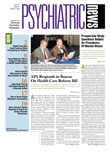Let's regain perspective.
After reading the letter “On the Decline of Psychotherapy” in the September 4 issue, I thought of several considerations.
In my lectures to medical students, I present them with an analogy. I tell them that psychiatry can be considered like a forest with many trees; depending on your training and experience, you focus on a particular tree disregarding or devaluing the other trees.
Some of my trees: I helped Dr. Walter Freeman to perform transorbital lobotomies, and in those years, I gave hundreds of ECTs. I trained in child psychiatry, I am board certified, I spent 13 years at the Washington Psychoanalytic Institute, and I did hospital psychiatry in the morning and saw selective patients in the afternoon whom I would treat with psychoanalysis or psychoanalytic psychotherapy.
Psychiatry went from tree to tree. There were indigestion and misunderstanding of psychoanalysis. Many doctors went as far as treating people with schizophrenia with psychoanalysis. The more one knew about psychoanalysis, the more one knew about its limitations. But the understanding and assessment of dynamics, ego strength, and so on have enabled me to evaluate cases in a manner that I could not have done without my psychoanalytic training. Another of my analogies to the students is that this type of evaluation is like an X-ray of a fracture, which enables you to see the magnitude of the fracture but does not cure it.
Progress in psychopharmacology has diminished or almost abolished the use of psychoanalysis, and I said “almost” because I understand the pendulum of psychoanalysis is beginning to swing back. I hope that it will not result in another misunderstanding of psychoanalysis.
The predominate aspect of psychiatry today consists in evaluating the patient in a 10- to 15-minute framework, eliciting symptoms, making a diagnosis according to DSM-IV on a phenomenological level, prescribing accordingly, and then referring to a social worker for psychotherapy; the insurance pays for it and everybody is happy. Pharmaceuticals are happy with the present state of affairs. Going back to my tree analogy, this is to look only at one tree.
To evaluate psychodynamically and to treat accordingly, if the patient is amenable, takes time, time of training, supervision, and so on. There are many trees; we should try to see the forest to decide which tree or trees are applicable to the case: medication alone, medication and psychotherapy, or ultimately psychoanalysis. When a person needs and can profit from psychoanalysis and goes through with it, the results are something to behold. Let's regain perspective.
MANUEL O. HERNANDEZ, M.D.
McLean, Va.
